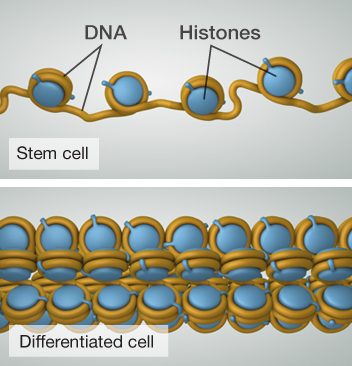Until fairly recently, cell differentiation was seen as final and irreversible. Once a cell became specialized, it was referred to as "terminally differentiated." It was considered locked-in and unable to become any other cell type.
However, in 2006, scientists reported that they had turned a differentiated cell back into a stem cell with the potential to become any type of cell in the body.
The difference between a stem cell and a differentiated cell is reflected in the cells' DNA. In a stem cell, the DNA is arranged loosely, with its genes ready to spring into action. As signals enter the cell and differentiation begins, genes that will not be needed are shut down, and genes that will be required for a specialized function remain open and active.
iPS Cells
Scientists noticed a small number of genes that were active only in stem cells and not in differentiated cells. Introducing just 4 of these genes back into differentiated cells made them behave like stem cells. The genes appear to be remodeling the cells' DNA, unlocking the genes that were shut down during differentiation.
The scientists named these cells "induced pluripotent stem cells," or iPS cells. In 2012, they won the Nobel Prize in Physiology or Medicine for their work.
STAP Cells
In 2014, a group of scientists announced that they had turned differentiated cells back into stem cells simply by stressing them. This surprisingly simple process, they claimed, quickly and efficiently generates stem cells without using any kind of genetic manipulation.
Unfortunately, the scientists' claims about STAP cells didn't hold up under scrutiny, and they ended up retracting their articles. iPS cells and other types of stem cells, however, are real. And researchers are working hard to find even more ways to coax differentiated cells back into a stem-like state.
Armed with the ability to reverse the differentiation process, scientists are exploring new ways to use stem cells in research and medicine.

In a stem cell, DNA (gold) is wrapped loosely around histone proteins (blue). In a differentiated cell, segments of DNA that are not required for the cell's specialized function are shut down and wrapped tightly around histone proteins.
References
Nature editorial staff (2014). Two retractions highlight long-standing issues of trust and sloppiness that must be addressed.Nature, 511, 5-6. doi: 10.1038/511005b
Takahashi, K. & Yamanaka, S. (2006). Induction of pluripotent stem cells from mouse embryonic and adult fibroblast cultures by defined factors.Cell, 126(4), 663-676. doi: 10.1016/j.cell.2006.07.024